Goldstein’s Renaissance Engineering Summer Camp Incorporates Art, Design, Mechatronics, and Mentoring
November 1, 2021

Lorena Escamilla, Jesus Zavala, and Molly Goldstein.
According to Industrial and Enterprise Systems Engineering (ISE) Teaching Assistant Professor Molly Goldstein, the idea for the brand new WYSE (Worldwide Youth in Science and Engineering) camp for 25 middle school students—Renaissance Engineering: Art, Design, and Mechatronics—came from a cardboard box. From that humble beginning, she and a pair of undergraduate students, Lorena Escamilla and Jesus Zavala, designed a virtual camp centered around two fun, hands-on, paper mechatronics activities sure to intrigue the younger students. Their goal was to pique participating middle schoolers’ interest in STEM. The hope was to firmly entrench the younger students, who are at a critical age, in the STEM pipeline. Here’s the story behind the story.
Because she has little kids at home, Goldstein had signed them up for an innovation camp for the summer of 2020, which hadn’t happened because of the pandemic. “They mailed us this kit—this box of wonderful, wonderful, cool things. And it sat there taunting me,” she admits.
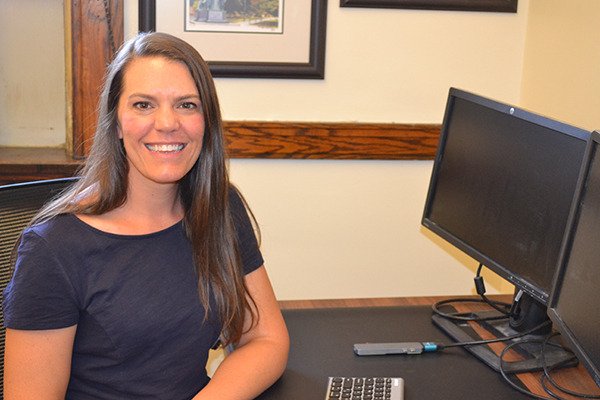 ISE Teaching Assisatant Professor Molly Goldstein.
ISE Teaching Assisatant Professor Molly Goldstein.Her kids, of course were frustrated, because that tempting box was just sitting there unopened. It’s not that Goldstein and her husband didn’t have the skills—her Bachelor’s and PhD are in engineering; her husband also has an engineering degree. “We should have been able to do that,” she admits. “We had no time—having three kids at home and having work. It was sitting there taunting me. And I thought, ‘If we can't do this—and we love STEM activities, and we have the background for it—and we're having a hard time!’”
Their plight opened her eyes to the dilemma countless families were doubtlessly also experiencing. Brainstorming about it with a friend at the University of Buffalo, she predicted, “We're going to lose kids. This year is going to impact so many families who don't have time, don't have resources.” So, they started looking for ways to get kids involved in STEM, despite the pandemic. Goldstein envisioned a summer day camp, one of whose components was her mentoring undergrads who would serve as near-peer mentors to the younger students and facilitate STEM activities. “Cool undergrads, right? For so many students, our undergrads are really just role models for them to look up to.”
Goldstein, with her passion for STEM education and her desire to inculcate her love for engineering and STEM education research into her students as well, decided it could be a win-win for everyone involved. “So, we talked about that and then being able to mentor the undergrads, which is a lower stake, lower time commitment for us, and that we as faculty can help mentor undergrads, who then, in turn, can do a lot of the troubleshooting with the kids.”
But why target middle school students? According to Goldstein, middle school literature says it's a really crucial age for a lot of underserved students, especially females. “That's an important age that we might miss them,” she explains.
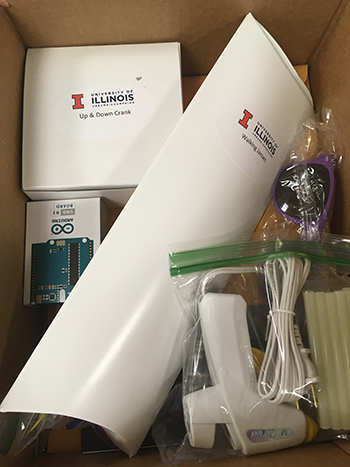 The box of goodies each Renaissance camp participant received.
The box of goodies each Renaissance camp participant received.So, from June 27–July 1, the summer of 2021, Goldstein and her undergrads piloted an ISE camp for middle school students called Renaissance Engineering: Art, Design, and Mechatronics. And, of course, extremely apropos, the kit of materials students at home would need to build the camp’s two fun paper mechatronics gadgets arrived in a tempting, taunting cardboard box.
Regarding Renaissance Engineering, isn’t the term somewhat of a dichotomy? The two seem worlds apart. Renaissance was mankind’s emergence from the Dark Ages; engineering is the modern application of science and math to design or make things in order to solve problems. Vis-à-vis the disconnect, Goldstein would say, “No.” Embracing the concept, she says its multidisciplinary emphasis, including the arts, is something she really loves about her department: “This is kind of the Renaissance engineering major. We do hand sketching still. We do some programming. We have understanding and a really broad background in engineering.” She goes on to cite the perennial Renaissance man, Leonardo DaVinci, whose still relevant groundbreaking designs exemplify the notion.
The camp’s main focus on paper mechatronics involved two main hands-on activities. Students built devices comprised of gears and moving mechanisms cut out of cardboard: 1) an Up-and-Down Crank (which as its name suggests, moves up and down) and 2) a Walking Janssen, which Goldstein describes as “kind of like a crab, if you think about it. They're really feasible for middle school students,” she claims regarding their two devices. “They're not scary.”
Re the up and down crank, students got to see how the parts fit together. Plus, two Arduinos were paired with them. “So, they're learning programming,” she boasts. “So, they're learning mechanisms, learning a little bit of computer science and the Procreate app, with some storytelling with it.” Students were to create their favorite characters with these mechanisms.
Following an initial lesson on perspective sketching, students began the process by drawing a design, “Because that's how the Renaissance artists started—sketching their idea…” Goldstein explains. “It's one way to communicate design ideas.” following a lesson on perspective sketching “So, I think it'll be kind of fun to get to the storytelling, to see how all of these fit together.”
Camp activities took place via three main platforms: 1) live sessions using video conferencing or webinar tools (Zoom); 2) “At-Your-Convenience” sessions comprised of videos, articles, and labs that students accessed through a password-protected website; and 3) Community Chat (e.g., GroupMe, Discord, Slack), accessible for any-time communication between campers, counselors, and course instructors.
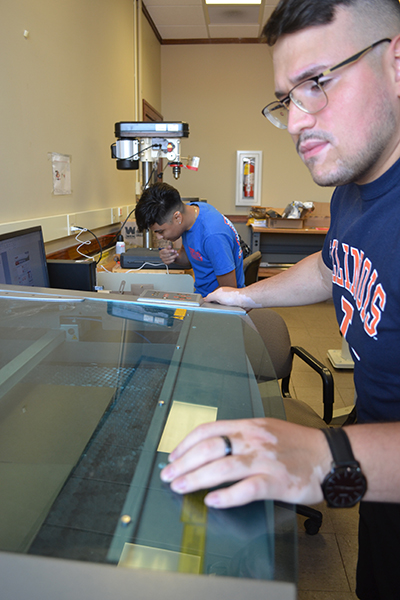 Jesus Zavala and Lorena Escamilla hard at work preparing for ISE's Renaissance WYSE camp.
Jesus Zavala and Lorena Escamilla hard at work preparing for ISE's Renaissance WYSE camp.Another program component included special speakers: Dr. Nidia Ruedas-Gracia from the College of Education’s Educational Psychology Department shared with students about a “Sense of Belonging.” Personnel from the Siebel Center for Design presented about storytelling and design. Plus, Meredith Blumthal, Director for International Programs in Engineering (IPENG) shared about international travel and engineering.
However, according to Goldstein, the camp was really driven by the undergrad students, who not only took charge of the workshops, but also provided mentorship to the students. And, while the middle school students ultimately benefitted from this learning experience, Goldstein claims the undergraduates definitely reaped rewards from the experience as well. “It's a good opportunity for the undergrad students to be doing service and in a meaningful way to them,” she explains, “which also helps them have a sense of belonging, contributing to their feeling like this is the right major for them, and that they're making big contributions.”
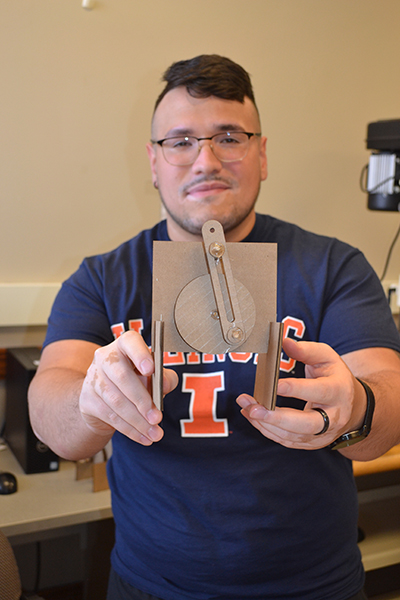 ISE rising senior Jesus Zavala shows off a finished up-and-down crank.
ISE rising senior Jesus Zavala shows off a finished up-and-down crank.Goldstein’s undergrad team was comprised of two students who had taken a course with her previously. One team member was Jesus Zavala, a rising senior in ISE. Zavala signed up for the project because he had been looking for an opportunity to expand his interests a little bit—dive deeper into design. Having taken Goldstein's class a couple of years ago, even working with fellow camp instructor Lorena Escamilla on a final project there, he admits:
“I just really, really enjoyed everything that we did there, and I knew I wanted to work again with the professor. And once I found out that the research that she was doing was based on both engineering education and design, I knew I had to get involved.” According to Zavala, Goldstein’s research is a perfect meld incorporating his past experiences working with students with multi-disciplinary engineering.
Plus, Zavala hoped to expose the middle schoolers to engineering—the same kind of exposure that had given him the impetus to study engineering himself. As a kid, first, he’d wanted to be a scientist, which evolved into his wanting to be an inventor…until middle school, when he says, “I learned that I could do both, and engineering was an actual thing…That's when I centered my interests into what I potentially wanted my career to be.”
Regarding the fact that their outreach is for middle schoolers, Jesus acknowledges, “I think it's incredibly important, particularly for me, just because I was in their position at one point. I didn't really know the capabilities or the range of what engineering held, and for them to be able to express a curiosity through a physical, tangible thing is super important.” He admits that in the midst of this outreach, he’d started picturing himself in their shoes—seeing himself as a kid again and had known that he would have appreciated the opportunity just as much as the kids did. “So being able to provide it is even, honestly, more rewarding,” he adds.
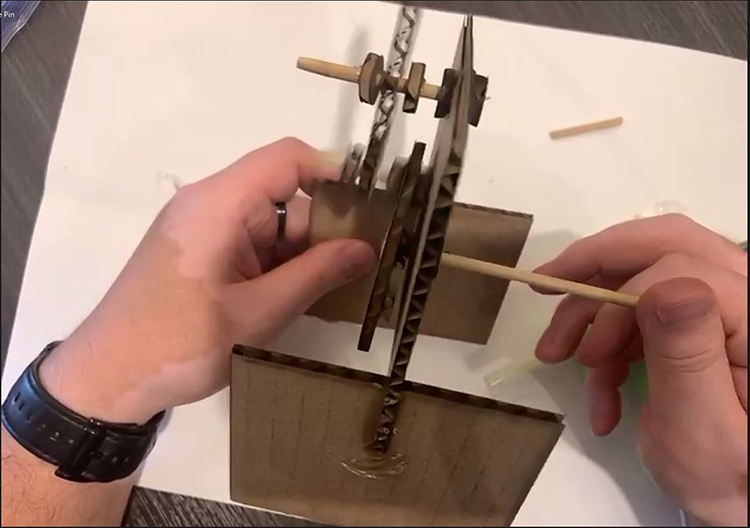 Jesus Zavala demonstrates how to construct one of the mechatronics projects during a Zoom session.
Jesus Zavala demonstrates how to construct one of the mechatronics projects during a Zoom session.Zavala’s hope for the younger students, besides learning some engineering principles through the two activities, was that they would understand the range of engineering, whether it be code design, aerospace-related things, or how machines work. “There's just so much that engineering can encompass,” he admits, and his goal was to help the students “just sort of see that it can be simplified down to electronic toys, for example. So, I think just make them feel comfortable within the space and just really express a curiosity through a variety of ways.” Adding that he was really excited to work with students in the classroom space, which COVID had put a halt on, he says it was really great to “re-immerse myself in that again.”
As might be expected, given his passion for working with younger students, his dream job is related to his two passions: engineering or possibly engineering education: “I'm kind of torn between either working for a company that designs aeronautical parts like NASA, but also, I've been around the educational space a lot ever since I was a kid,” he admits. “I think working within a maker space in Chicago, where I'm able to still work with kids and sort of stay within that kid's spirit, just sort of building up the curiosity that I also had as a kid within the STEM field would be something that I would really like to stay at. So, I still wanna be involved with that in the future.”
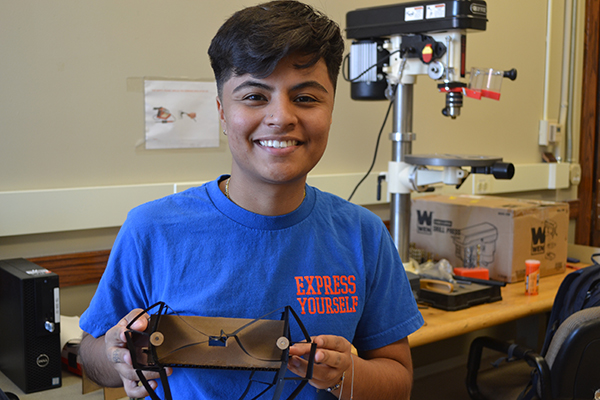 Lorena Escamilla exhibits the second paper mechatronic project: the Walking Janssen.
Lorena Escamilla exhibits the second paper mechatronic project: the Walking Janssen.The second undergrad was rising ISE senior in Systems Engineering and Design, Lorena Escamilla, whose dream job is to be a product design engineer working with prototypes out on the west coast. She reports signing up to help with the camp because she’d been looking for a research opportunity. “Professor Goldstein had always been one of my favorite professors,” she acknowledges, “So I just reached out to her to see if she had any opportunities for students, especially juniors. And luckily, she did.” So, Escamilla is now involved in paper mechatronic research under her.
The rising senior shares how she ended up in engineering. Recalling that although she was good at math and science in grade school and middle school, she claims she wasn't exposed to engineering until high school, when she started taking engineering classes. “That's why I like what I'm doing now under Professor Goldstein,” she says about the opportunity to work with younger students and teach them. “I wish I had had that exposure when I was their age.”
Her goal for the camp was for the youngsters to leave the camp and explore on their own, to “look into engineering” to discover “what it is exactly.” While she and Zavala hoped to introduce the middle schoolers to their field, she wanted to have a significant impact on the students so that “hopefully they go out and explore it and for sure see themselves in that career path.” While she’s not sure if the kids are thinking about their careers this far ahead, she says, “But if they do start thinking about it, that's kind of what I want to do as well—have them thinking about it now, saying to themselves, ‘Yeah. I want to be an engineer!’
The Renaissance camp also had an added benefit in that it was able to impact students beyond the local students who would normally be able to take part. Because this year’s camp was virtual due to the pandemic, it allowed students outside of Illinois to be involved as well. Excited that her camp provided an opportunity for students living in places with little diversity to meet others from different backgrounds and histories, Goldstein was hopeful that it might help to broaden their perspective.
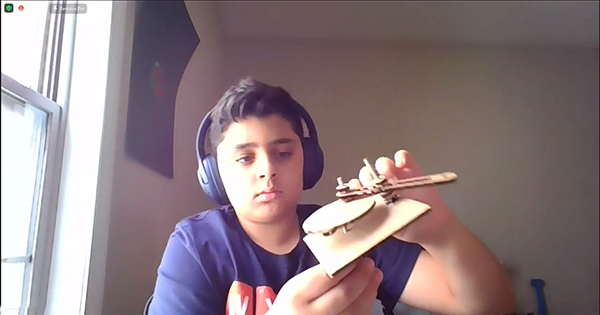 A Renaissance camper assembles his up and down crank during a Zoom session.
A Renaissance camper assembles his up and down crank during a Zoom session.However, Goldstein acknowledges that while this summer’s version of the camp was quite successful, it’s not set in stone, but will likely have many adaptations. Goldstein claims that, “Like an engineer we're testing so that we can iterate for a next time. And this is our first—our first prototype—to see if it really works.” As Goldstein entered the first iteration of this camp, many long-term goals were in place, ultimately prioritizing the program’s impact on others. At one level, the impact can be seen towards middle school students, but even beyond that, to the undergraduate mentors and students.
In Goldstein’s own words, she hopes that this camp can make students feel “like engineering really is for them. And for the middle school students, that they consider STEAM more broadly. And if they consider our department at Illinois? Even better.”
Goldstein also hoped that, for the younger students, the camp was more than just, “This is a career for you, but these are ideas that could be fun for you, and you could see yourself being interested in this…So that's my hope, that these 25 students then consider STEM in some way later.”
Story by Elizabeth Innes and Garima Sharma.












.jpg)
















